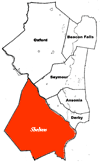Shelton - A Brief HistoryThe Shelton area was first occupied by the Pootatuck hunting tribe, located along the Housatonic River. In 1659, Moses Wheeler was the first European to purchase land from the Pootatucks in the White Hills section of the city, and in 1662 Stratford’s Joseph Judson bought land near the Far Mill River. The first English settlers pushed out of Stratford in 1680, establishing farms in Coram, as they called the Long Hill section of Shelton. The Native Americans were given a reservation at Coram which they occupied until 1732, when they abandoned the area for more northern lands. The village grew until, in 1717 fifty families sought parish status for their settlement, and the Connecticut General Assembly granted this petition, establishing Ripton Parish. A church was built in 1720, and in 1724 Rev. Jedediah Mills of Windsor was ordained the first minister. The heart of the parish was the Huntington green, with farms and mills of various types located along the rivers at the outskirts. Many residents served in the French and Indian Wars, and citizen David Wooster became a colonial general. During the Revolution, he renounced his royal command to join the patriot cause. Other Ripton citizens joined the militia at Bunker Hill, Long Island and Danbury, where General Wooster lost his life. Supplies were secretly removed from Danbury under British attack, and hidden in a Birdseye Road outbuilding in Shelton. In 1781, French officers, part of a 600-man force, were entertained in Huntington en route to Monroe and a later participation with George Washington in the Yorktown victory. Through this period, the parish continued to grow, and in 1789 Ripton and New Stratford parishes broke off from Stratford to form the separate town of Huntington, named for Samuel Huntington of Norwich, a signer of the Declaration of Independence and Governor of Connecticut from 1786 to 1796. Farming, even using slave labor, remained the primary occupation in the town, but in the late 1700s the Leavenworth family undertook shipbuilding in competition with the shipyards of Derby. these ships traded along the east coast and entered the lucrative West Indies trade. After 1800, however, bridges were built down river, blocking shipping. Maritime laws enacted before the War of 1812 and the increase in piracy closed down shipping from Huntington. Subsequently, migration to the west increased and the population declined. In 1823, New Stratford separated from Huntington to become the separate town of Monroe. As the nineteenth century progressed, dairy and other farm products became a main source of revenue when sold in cities. Huntington farms were among the early ones to adopt mechanized and scientific farm techniques. Farm societies were formed, and agricultural fairs held. Politically, the Jacksonian Democrats led by William L. Bennett controlled Huntington for almost fifty years, and during the Civil War, Huntington sent 58 privates to fight for the Union. At home, the Ousatonic Water Company in 1863 began to construct a dam across the Housatonic River, and after several washouts, it was completed in 1870. Unfortunately, the completed dam washed out in 1891, necessitating a different, sloping apron style of construction for its replacement. The Company then began to promote Huntington as a site for industry, advertising its canal as a source of water power. It rented parcels of its acreage to companies that by 1896 numbered twenty-five. to accommodate the new businesses and to carry their freight, the railroad was extended from Derby in 1888 through Shelton to Newtown. To cross over the canal and railroad, an iron viaduct Bridge was constructed that year as well. In 1899, a trolley line was built in the City, linking Shelton with Derby and nearby towns. Industry thrived in the prewar period. Two of the largest manufacturers were the Derby Silver Company, whose factory still may be seen on the right of the Derby-Shelton bridge as one heads toward Derby. German, Irish, Italian and Slavic immigrants streamed in to take the jobs offered by the new factories. The manufacturing area became a borough named for Edward Shelton, a founder of Sanford & Shelton Company in 1836, the first tack factory in the United States, that he moved from Derby to Shelton in 1871. In 1882, Shelton became the legal name of the Huntington borough, and in 1917 the City of Shelton was established. Two years later, after receiving the voters’ support, the name Huntington was changed to Shelton, and the town incorporated into the City of Shelton, with Edward W. Kneen as the first mayor. After World War I, industries began to move south, attracted by cheaper labor, and many of those that survived did not last through the Depression. During these difficult days, Shelton was a leader in unemployment relief, issuing bonds to support the unemployed. Following World War II, building boomed and the population doubled. In 1975, industry was dealt a mortal blow with the arson destruction of the Sponge Rubber Factory. But that same year Route 8 opened, linking Shelton with Winsted and Bridgeport, and expediting Shelton’s transformation to a bedroom community for Stamford and even New York. |
